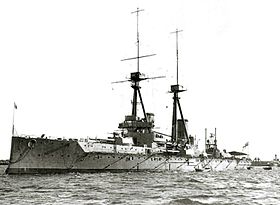Bellerophon class (1907)
|
|
|
|---|---|
| Bellerophon class | |
 HMS Bellerophon |
|
| Overview | |
| Type | Battleship |
| units | 3 |
| Technical specifications | |
| displacement |
18,800 ts design |
| length |
160 m |
| width |
25 m |
| Draft |
8.4 m |
| crew |
733 |
| drive | |
| speed |
20.75 kn |
| Range |
5720 nm at 10 kn, 4250 nm at 18.3 kn |
| Armament |
|
| Armor |
Side armor
Underwater protection
Turrets
Command tower
|
The Bellerophon class was a British class of battleships before and in the First World War . The Bellerophon class included the HMS Bellerophon , the HMS Temeraire and the HMS Superb .
history
The three ships of the Bellerophon class were approved as successors to HMS Dreadnought in 1906 . The gun arrangement of the Dreadnought was retained, but the armor was slightly improved and the caliber of the anti-torpedo boat artillery increased. All three ships belonged to the Home Fleet and the Grand Fleet and were scrapped according to the provisions of the Washington Fleet Agreement of February 6, 1922.
draft
The 12-inch guns of the main armament were set up as with the Dreadnought in five twin towers, three of which stood amidships and two were arranged as wing turrets. The caliber of the anti-torpedo boat guns has been increased to 4 inches. The guns were set up individually without armor protection in the superstructure or freely. In 1914 the number of guns was reduced to 14 and in 1916 to 12. From 1915, the ships carried anti-aircraft guns of the 3 inch (76 mm) caliber.
In contrast to the Dreadnought , the Bellerophon class received a continuous torpedo bulkhead as underwater protection. Outwardly, the Bellerophon class differed from the Dreadnought in that it had two tripod masts and two chimneys of equal height.
Ships of the class
- The HMS Bellerophon was launched in Portsmouth Dockyard on July 27, 1907 and was completed in February 1909. On May 26, 1911, she collided with HMS Inflexible , and on August 28, 1914 with the cargo ship St. Clair . In the First World War she belonged to the Grand Fleet and took part in the Battle of the Skagerrak . From 1919 it was part of the reserve. In November 1921 it was sold for demolition and in 1923 it was broken up.
- The HMS Superb was launched on November 7, 1907 at Armstrong's shipyard in Elswick near Newcastle and was delivered on May 29, 1909. In the First World War she belonged to the Grand Fleet and took part in the Battle of the Skagerrak. In 1918 she was detached to the Mediterranean Fleet . After the armistice with the Ottoman Empire , it led the first allied naval formation through the Dardanelles and operated temporarily in the Black Sea. From 1919 she belonged to the reserve fleet, in 1920 she became a target ship for artillery. In December 1922 she was sold for demolition and broken up.
- The HMS Temeraire was launched in Devonport Dockyard on August 24, 1907 and delivered in May 1909. In the First World War she belonged to the Grand Fleet and took part in the Battle of the Skagerrak. In 1918 she was detached to the Mediterranean fleet together with HMS Superb . From 1919 she was a seagoing cadet training ship, in December 1922 she was sold for demolition and scrapped.
literature
- Breyer, Siegfried: Battleships and battle cruisers 1905–1970. JF Lehmanns Verlag, Munich 1970. ISBN 3-88199-474-2